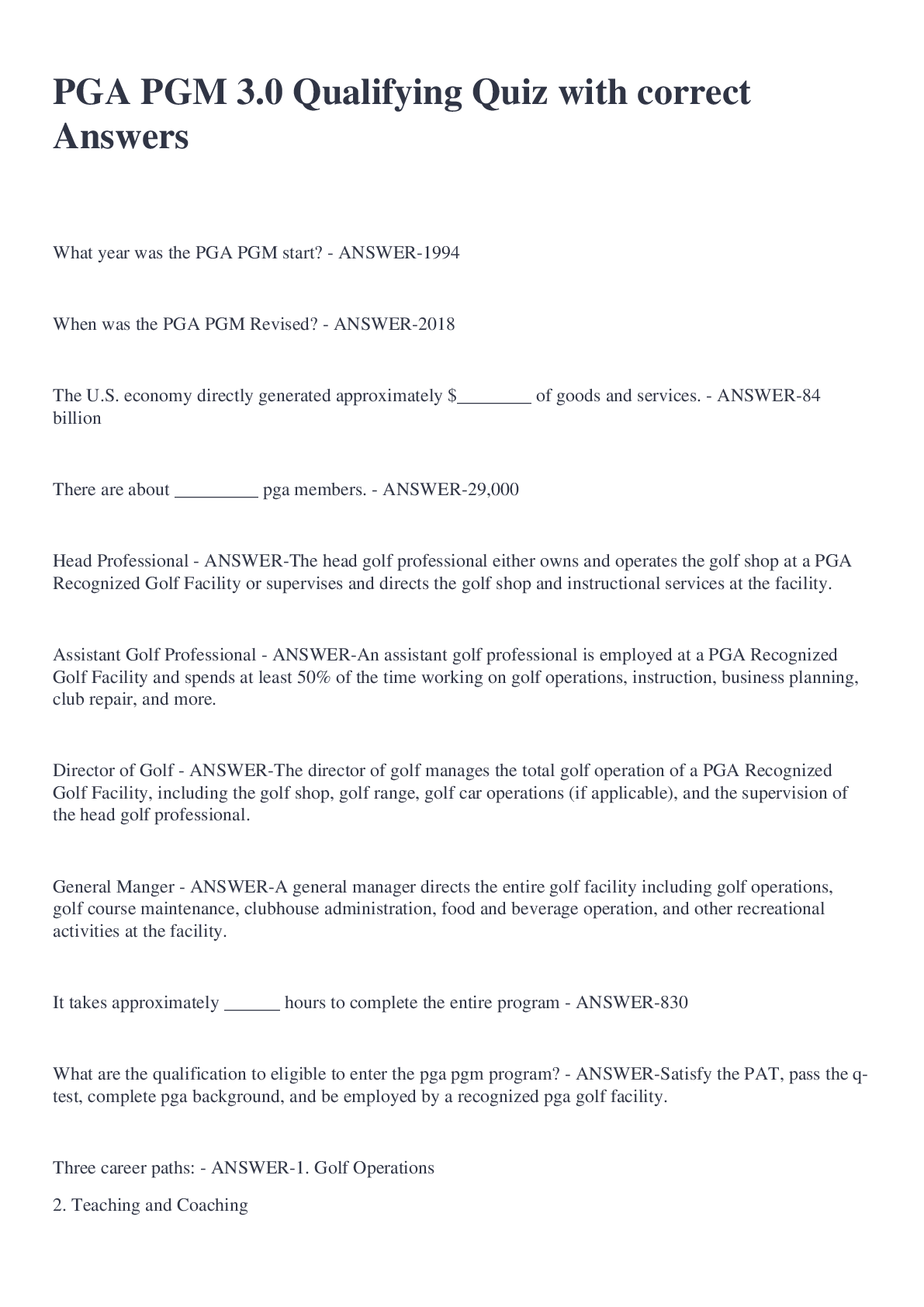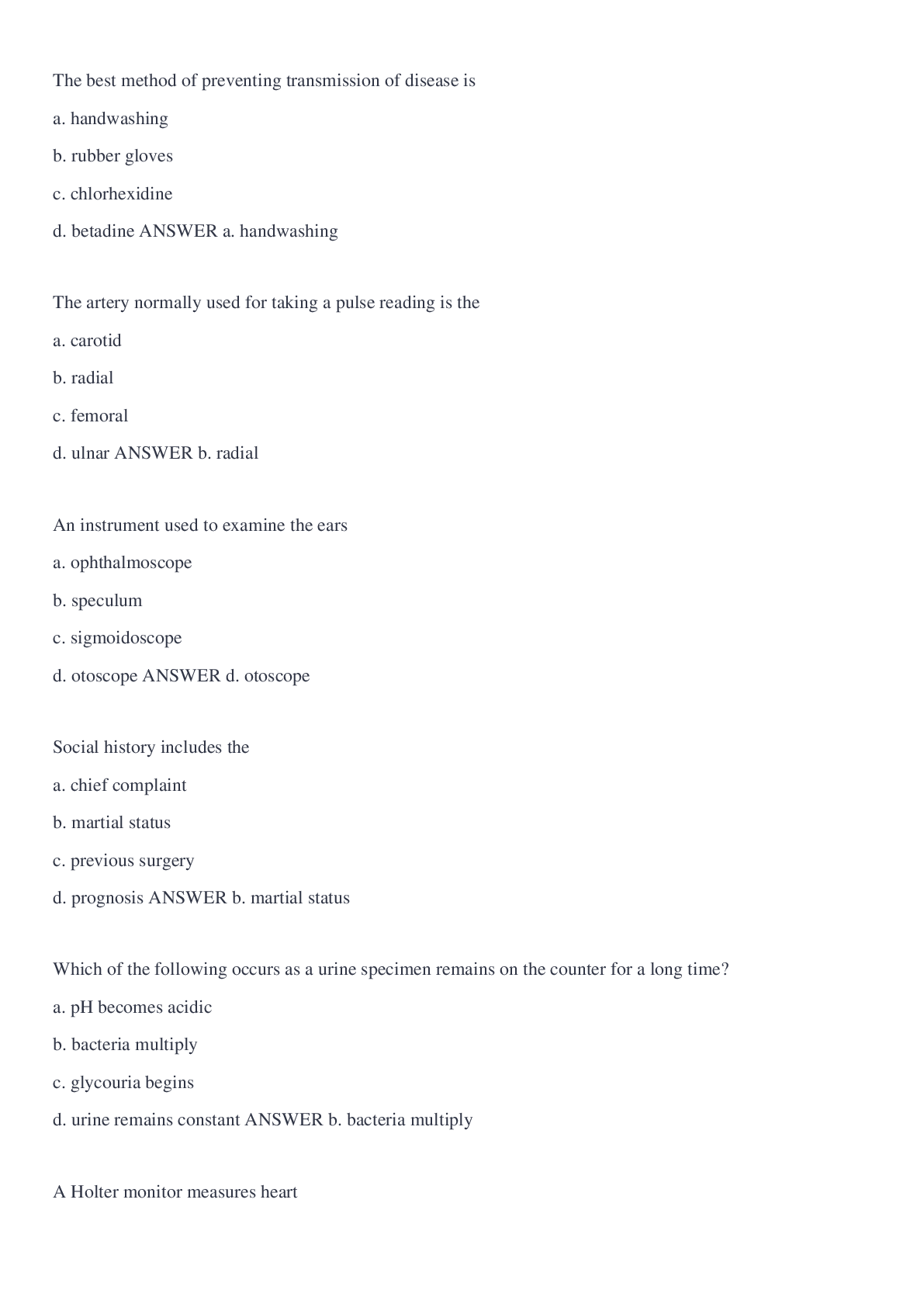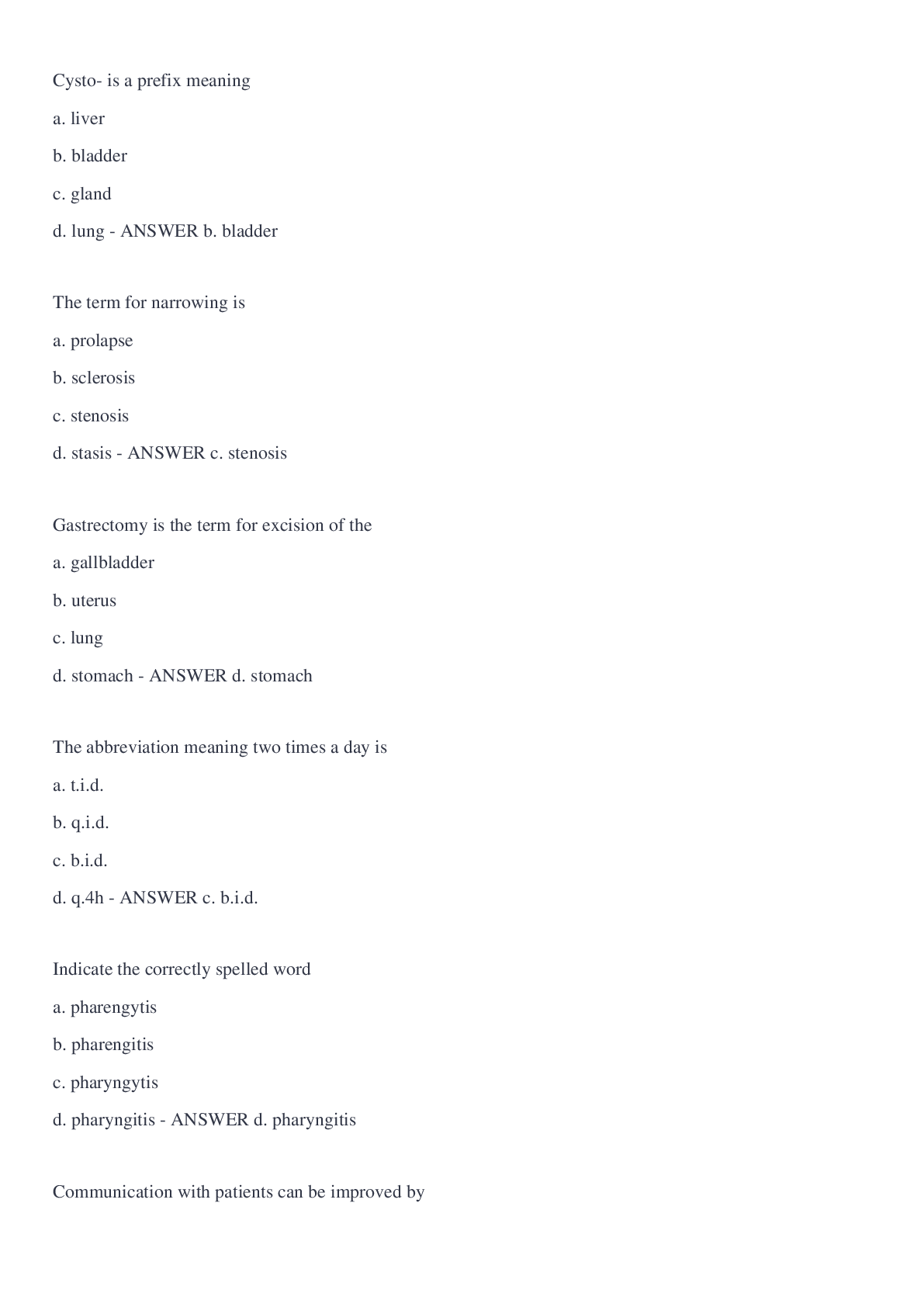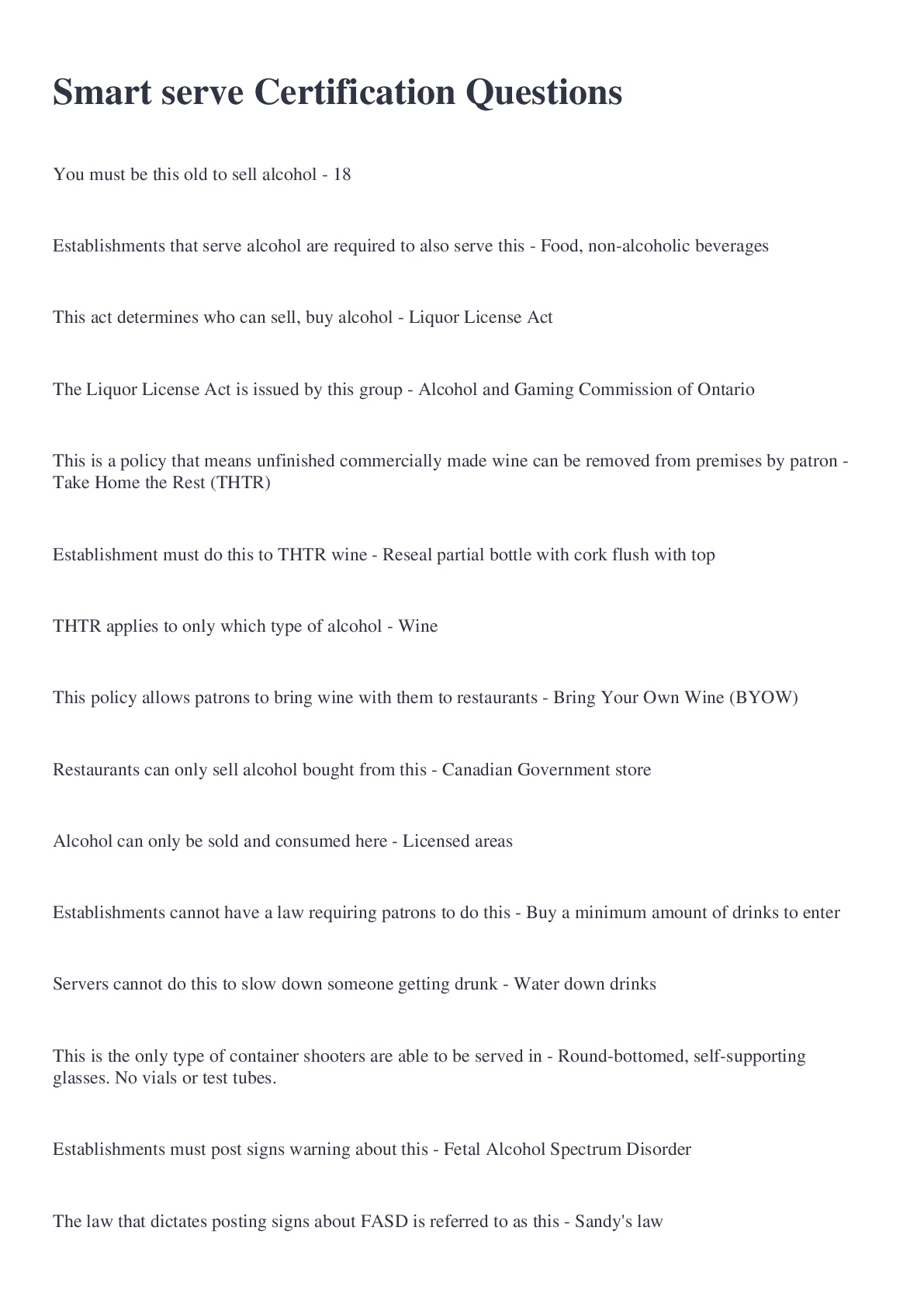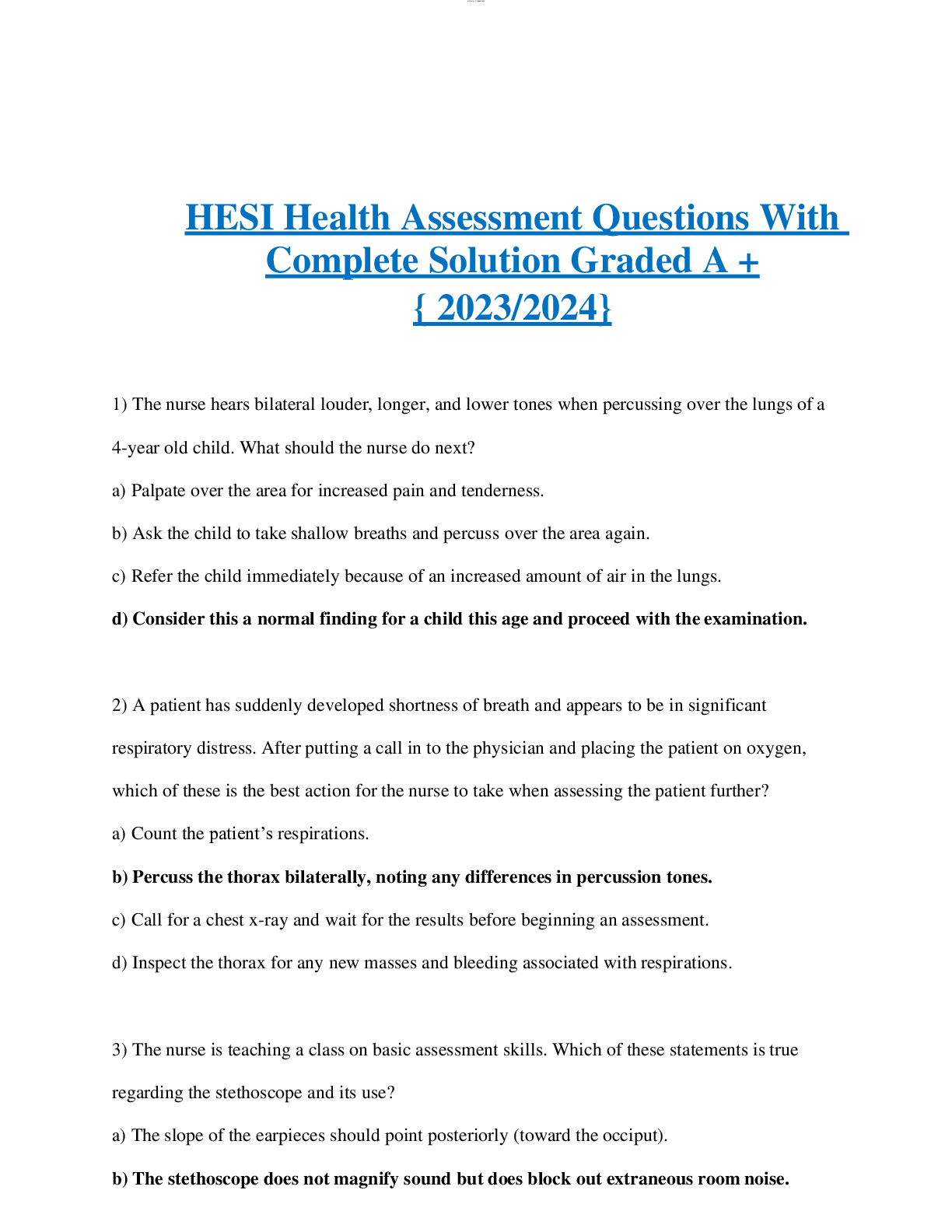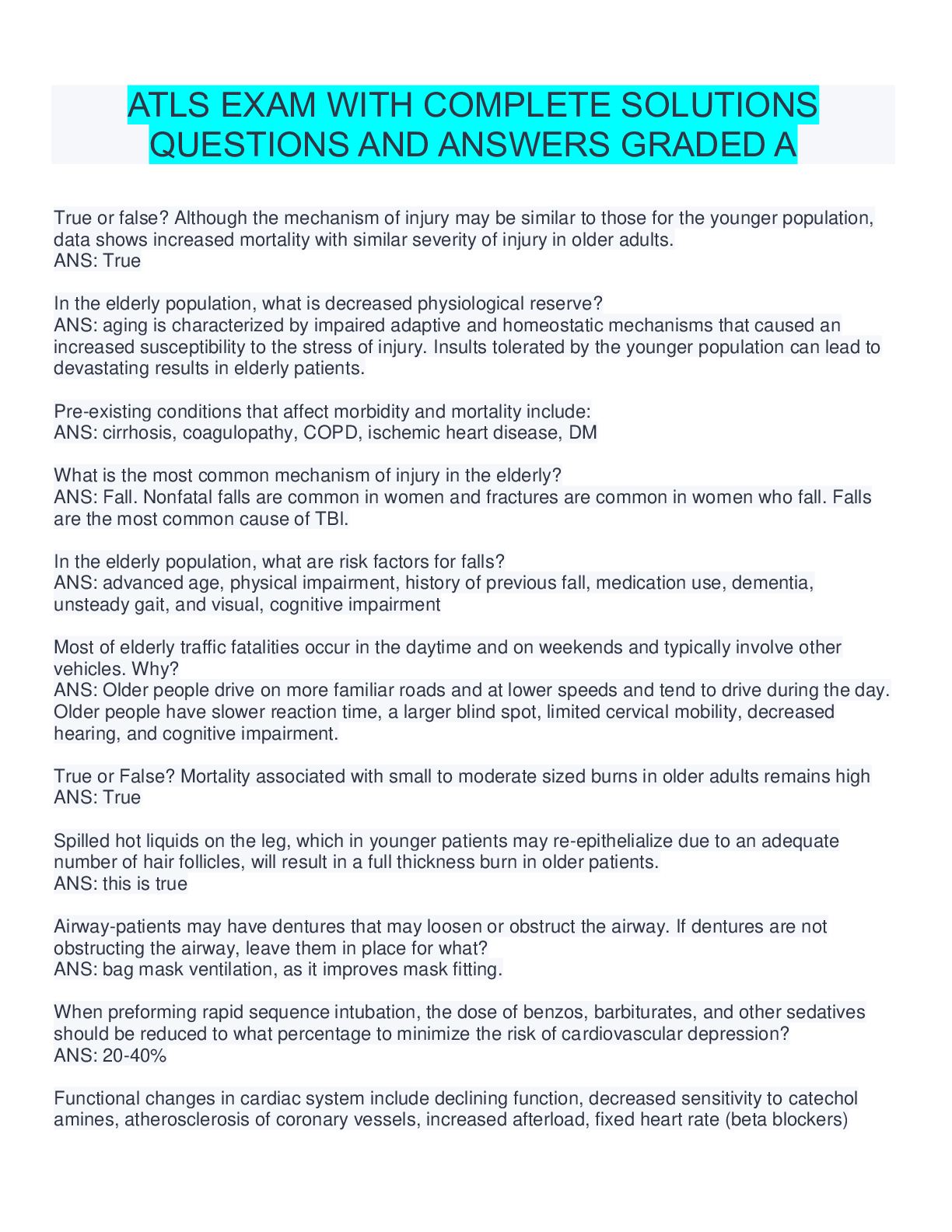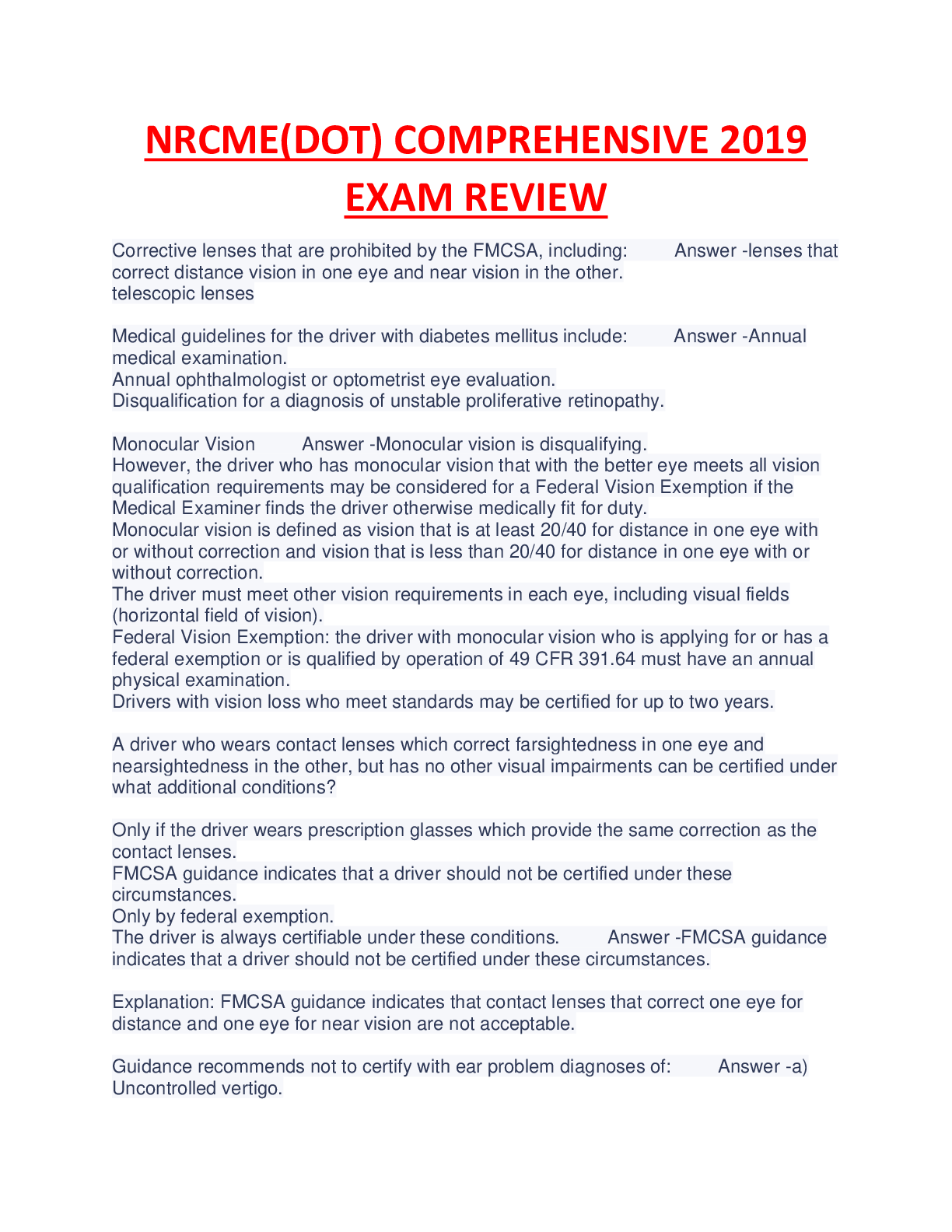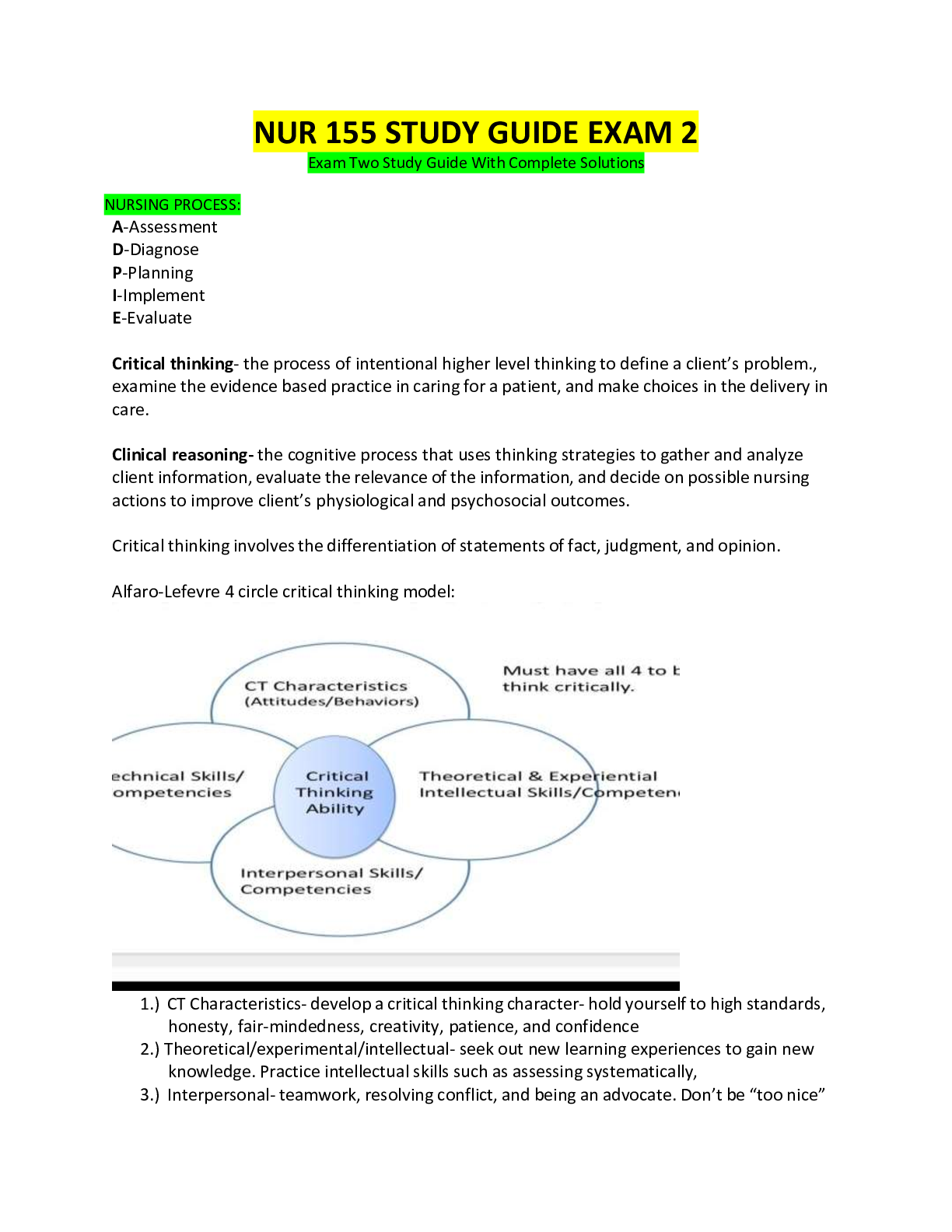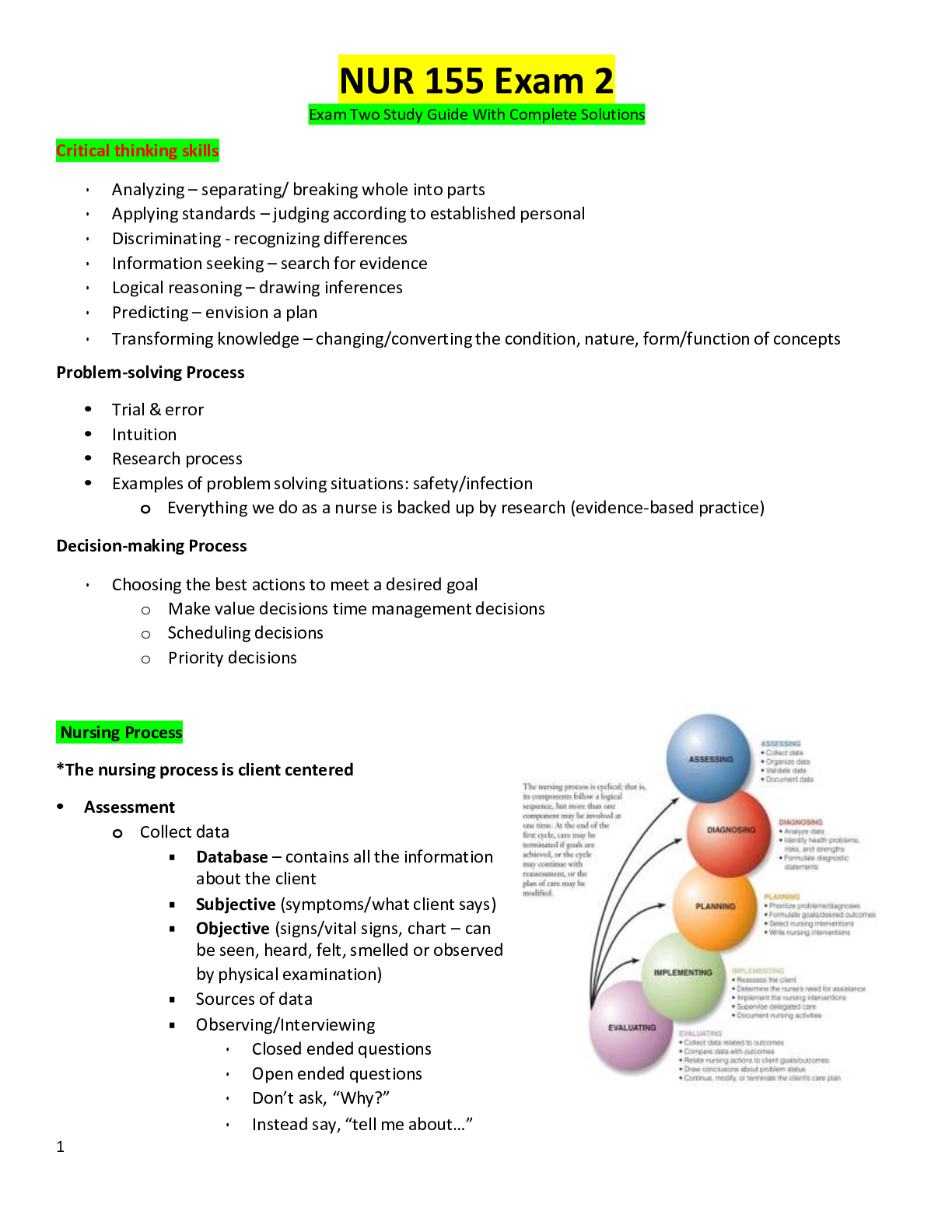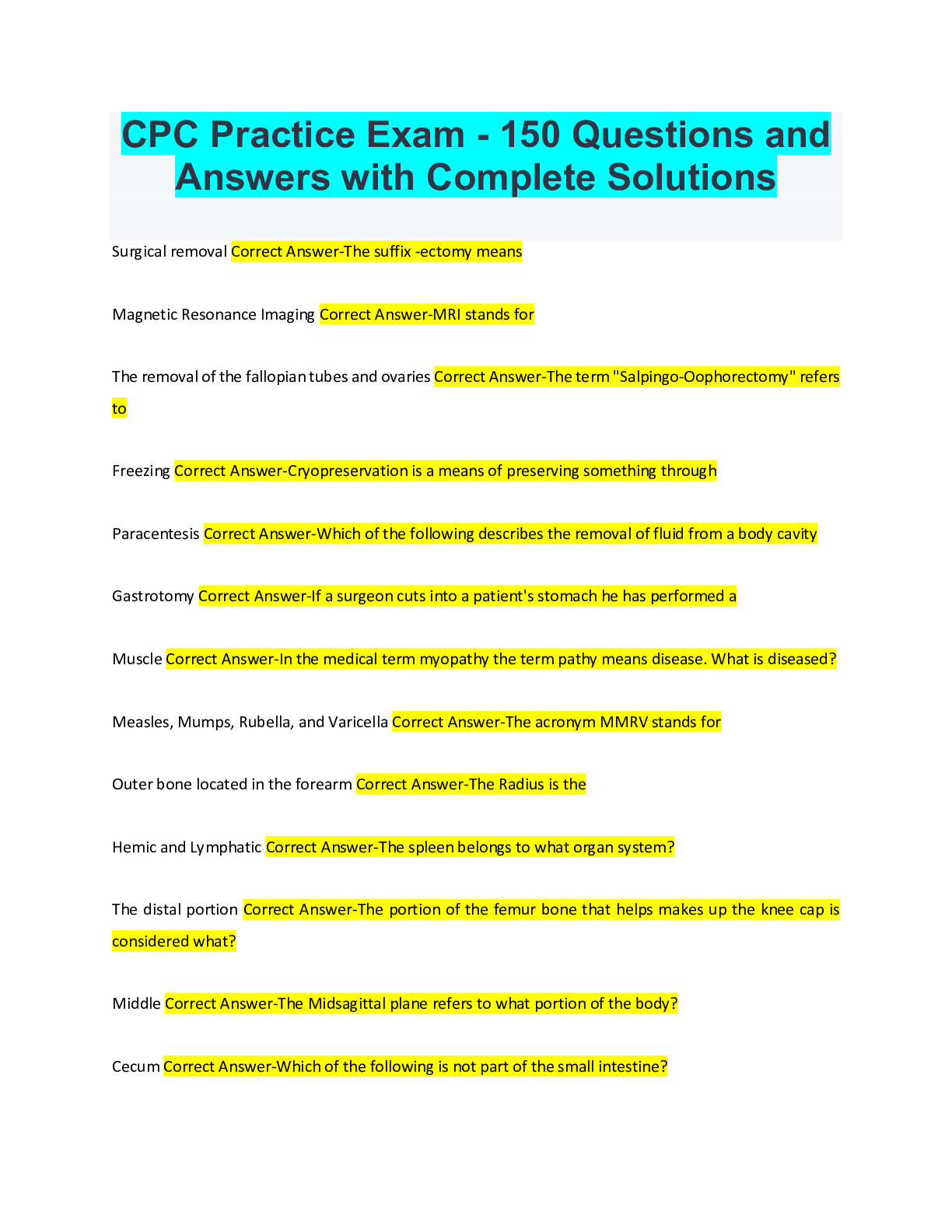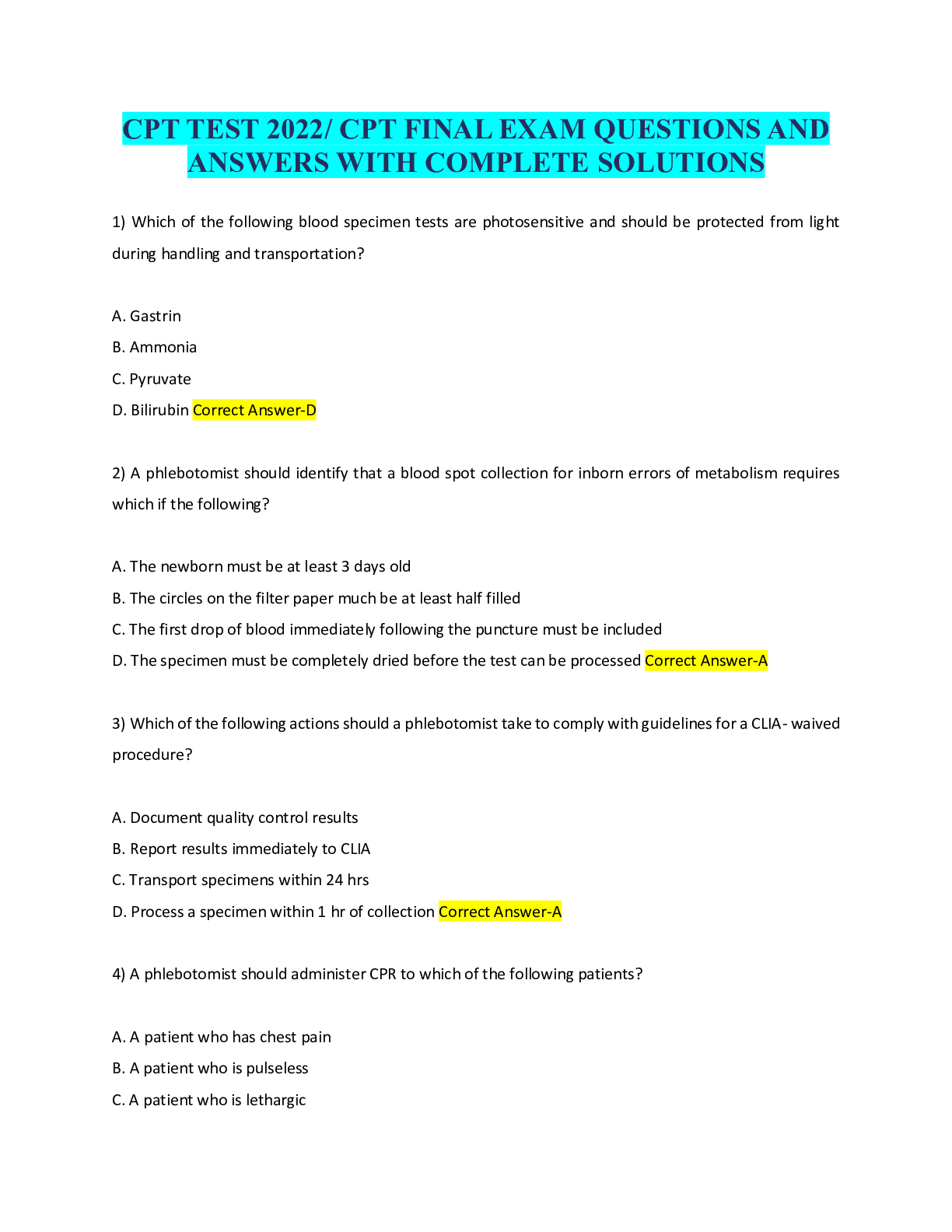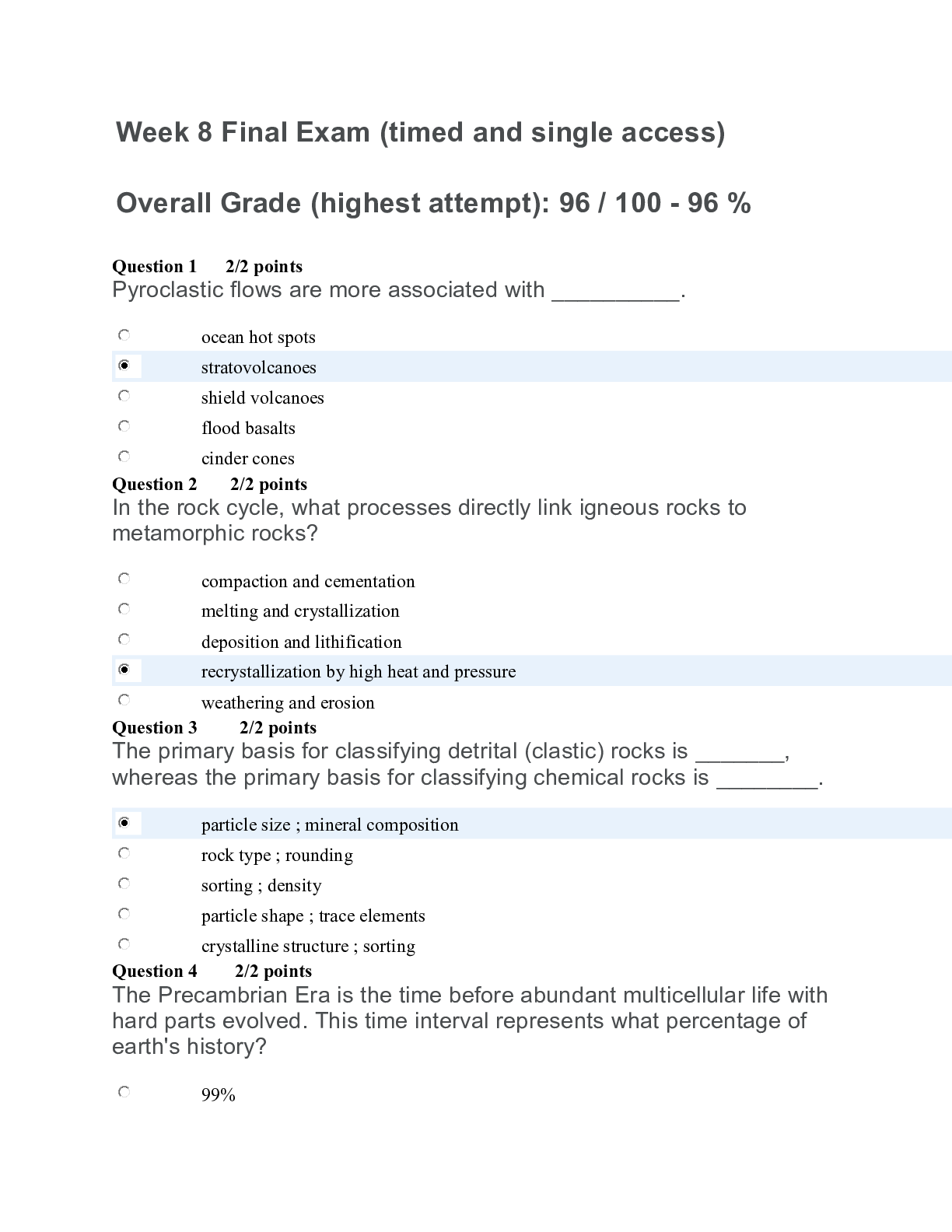hazmat awareness practice test 2022 with complete solutions
Document Content and Description Below
compared to other types of incidents to which first responders are commonly called, hazardous material incidents typically___________. A. are shorter in duration B. are more complicated C. produ... ce a higher rate of false alarms D. results in more injuries - ANSWER are more complicated by which acronym are the federal regulations detailing hazardous materials response competencies collectively known______. A. HAZEL B. HAZWOPER C. SARA D. HSC/HHC - ANSWER B. HAZWOPER the DOT definition of hazardous materials focuses on those materials that are_______. A. intrinsically harmful B. not properly controlled C. transport in bulk D. in the process of transport - ANSWER B. not properly controlled which of the following actions is permitted for operations-level hazardous materials responders? A. closing a remote value B. product transfer C. overpackaging D. rescue - ANSWER A. closing a remote valve which federal agency enforces and publicizes laws and regulations governing transportation of hazardous materials? A. Environmental Protection Agency B. Department of Transportation C. Interstate Commerce Commission D. Department of Energy - ANSWER B. Department of Transportation Are above-ground storage tanks pressurized or nonpressurized? A. pressurized only B. nonpressurized only C. either D. neither - ANSWER C. either which NFPA standard deals with various aspects of hazardous materials emergency response? A. 1901 B. 1002 C. 473 D. 10 - ANSWER C. 473 which group within the NFPA produces the hazardous materials response standards? A. technical committee on hazardous materials response personnel B. special task force on hazardous materials substances, responses, and disposal C. scientific and technical committee for field applications D. study group on the integration of applicable hazardous materials - ANSWER A. technical committee on hazardous materials response personnel what is the minimum level of hazardous materials training for hazardous materials? A. operations B. awareness C. specialist D. technician - ANSWER A. operations which law requires businesses that handle chemicals to report the type, quantity, and storage methods for these chemicals to the local fire department? A. local emergency planning act B. hazardous waste operations and emergency response act C. superfund amendment and reauthorization act D. emergency planning and community right to know act - ANSWER D. emergency planning and community right to know act What does HAZWOPER stand for? - ANSWER Hazardous Waste Operations and Emergency Response The bulk of the new chemicals introduced each year fall into one of three categories. Which of the following is one of them? A. medicines B. military products C. paints and coatings D. lawn care products - ANSWER D. lawn care products what should be the primary focus when preplanning for hazardous materials incidents? A. existing threats in the area B. history of past incidents C. the most vulnerable exposures D. likely terrorists targets - ANSWER A. existing threats in the area ideally when should reponse to a hazardous materials incident begin? A. upon receipt of the alarm B. after identifying the materials involved C. during preincident planning D. upon arrival at the scene - ANSWER C. during preincident planning In general, which factor has the most influence on the actions taken at a hazardous materials incident? A. the initial actions of first responders B. the properties of the specific chemicals involved C. fixed facility versus transportation accident D. weather conditions - ANSWER B. the properties of the specific chemicals involved defensive hazardous materials operations are those actions taken to_________. A. minimize the volume of the release B. control the incident perimeter and isolate the hazard C. prevent the situation from deteriorating D. contain the release from a safe distance - ANSWER D. contain the release from a safe distance Approximately how many chemicals are registered for commercials use in the Unites States? A. 10,000 B. 25,000 C. 80,000 D. 200,000 - ANSWER C. 80,000 What is the minimum level of hazardous materials training required to take defensive actions? A. awareness B. technician C. operations D. specialist - ANSWER C. operations what is the temperature at which a liquid continuously gives off vapors? A. evaporation point B. flash point C. boiling point D. fire point - ANSWER C. boiling point what is the temperature at which flammable liquid will ignite without any external ignition source? A. fire point B. flash point C. lower explosive limit D. ignition temperature - ANSWER D. ignition temperature Why are flammable liquids with low boiling points dangerous? A. ignition temperature is proportional to boiling point B. such liquids react more readily with other substances C. such liquids typically have a high vapor density D. such liquids produce large volumes of flammable vapor at relatively low temperatures - ANSWER D. such liquids produce large volumes of flammable vapor at relatively low temperatures Which toxic chemical is produced by the burning of wood? A. copper chlorate B. organic peroxide C. cyanide D. acetic acid - ANSWER C. cyanide which type of agent is also known as a riot-control agent? A. deterrent B. choking C. irritant D. smothering - ANSWER C. irritant which section of the Emergency Response Guidebook (ERG) contains the guides? A. green B. yellow C. blue D. orange - ANSWER D. orange what is the vapor density of air? A. 14.7 B. 7 C. 1 D. 0 - ANSWER C. 1 Which term means the volume increase that occurs when a liquid materials changes to a gas? A. coefficient of vaporization B. evaporation rate C. expansion ratio D. evaporation volume - ANSWER C. expansion ratio according to the NFPA, what is defined as a materials capable of posing an unreasonable risk to health, safety, or the environment? A. containment B. hazard C. dangerous god D. exposure - ANSWER B. hazard what is the term for the process by which people, animals, the environment, and equipment come into contact with a hazardous material? A. contamination B. absorption C. contact D. exposure - ANSWER D. exposure Which mnemonic helps firefighters remember the 7 categories of harm that can be caused by terrorism agents or other hazardous materials? A. WAFFLES B. PANOPRY C. TRACEMP D. CALLUPP - ANSWER C. TRACEMP which particle has a positive charge? A. electron B. photon C. proton D. neutron - ANSWER C. proton Which of the following is the most toxic nerve agent? (*) A. sarin B. soman C. VX D. Tabun - ANSWER C. VX Twitching is a hallmark of exposure to which type of agent? A. nerve B. blister C. cyanide compound D. choking - ANSWER A. nerve which type of agent prevents the body from using oxygen? A. cyanide compound B. irritant C. choking D. nerve agent - ANSWER A. cyanide compound what is the flash point of gasoline? A. --43F (--41C) B. --23F (--30C) C. --10F (--12C) D. --23F (--5C) - ANSWER A. --43F (--41C) which sort of change is combustion? A. chemical B. physcial C. endothermic D. hypergolic - ANSWER A. chemical which of the following is an example of a secondary contamination? A. contamination by airborne vapors B. contact with the materials during a defensive operation C. stepping in a contaminated liquid pool D. handling a contaminated tool - ANSWER D. handling a contaminated tool What do Dewar containers hold? A. foodstuffs B. compressed gas C. liquids for transport via air D. cryogenic liquids - ANSWER D. cryogenic liquids In the blue and yellow sections of the ERG materials with a toxic inhalation hazard are: A. underlined B. highlighted C. italicized D. in bold print - ANSWER B. highlighted What is the maximum capacity of an intermodal tank? (*) A. 1500 gallons B. 3000 gallons C. 4500 gallons D. 6000 gallons - ANSWER D. 6000 gallons The time of onset for symptoms from the chemical agents used by terrorists is: (*) A. seconds B. minutes to hours C. days D. weeks - ANSWER B. minutes to hours what does the NFPA 704 marking system address? A. Initial actions at a material release B. Hazardous materials at a fixed facilities C. Compliance with the Hazard Communication Standard D. Hazardous materials transportation - ANSWER B. Hazardous materials at a fixed facilities what is the typical maximum pressure reading for a standard oxygen cylinder used in the medical field? (*) A. 1000psi B. 2000psi C. 3000psi D. 4000psi - ANSWER B. 2000psi Which marking system complies with the OSHA Hazard Communication Standard? (*) A. Hazardous Materials Information System B. NFPA 704 C. Material safety data sheet D. DOT placard - ANSWER A. Hazardous Materials Information System Which cargo is carried by a highway tanker that has a smaller-diameter tank with several reinforcing rings around the circumference? A. paving materials B. nonpotable water C. corrosives D. flammable liquids - ANSWER C. corrosives Which free service can be accessed to connect fire fighters with chemical manufacturers, chemists, and other specialists during a chemical incident? A. National Response Center (NRC) B. Department of Transportation (DOT) C. Bureau of Explosives (BOE) D. CHEMTREC - ANSWER D. CHEMTREC What is the term for shipping papers carried on railroad transportation? A. waybill B. freight bill C. manifest D. switch list - ANSWER A. waybill which section of the ERG lists chemicals by their UN identification numbers? A. Green B. Yellow C. Blue D. Orange - ANSWER B. Yellow What is the most commonly contained in large, above-ground, horizontal storage tanks? A. compressed gas B. corrosive liquid C. flammable or combustible liquids D. liquid foodstuffs - ANSWER C. flammable or combustible liquids Which item must be included on a pipeline warning sign? A. UN ID number B. emergency contact number C. ERG guide number D. signal word - ANSWER B. emergency contact number what color is a DOT transportation placard for poison? (*) (on test) A. white upper half with black lower half B. red C. white D. orange - ANSWER C. white In the NFPA 704, which color indicates reactivity? (on test) A. orange B. yellow C. red D. green - ANSWER B. yellow what does the blue section of the NFPA 704 marking system indicate? (on test) A. flammability B. reactivity C. special symbols D. health hazard - ANSWER D. health hazard a high pressured intermodal tank is commonly used to transport __________. A. liquefied gases B. cryogenic liquids C. flammable liquids D. corrosives - ANSWER A. liquefied gases which of the following is an identifying characteristic of an intermodal tank? A. a box-like steel frame B. multiple full length tank tubes C. an elliptical tank cross section D. a sloping tank bottom - ANSWER A. a box-like steel frame which materials is commonly used for large-volume nonpressurized horizontal storage tank shells? A. aluminum B. polyethylene C. manganese D. carbon composite - ANSWER A. aluminum what is the first major heading on an MSDS? (*) A. hazards identification B. safe handling guidelines C. product identification D. composition - ANSWER C. product identification which information is critical for proper selection of PPE? A. decontamination options B. physical and chemical properties C. proximity to contaminant D. confinement method - ANSWER B. physical and chemical properties A motor vehicle accident causes a small gasoline spill. This is a level____ incident. (*) A. I B. II C. III D. IV - ANSWER A. I what is the appropriate agency to call upon discovery of a hazardous materials? A. National Fire Protection Agency B. US Fire Administration C. Environmental Protection Agency D. National Response Center - ANSWER D. National Response Center (NRC) Hazardous materials operations-level responders should preform only those actions that_____________. (*) A. do not involve contact with the material B. can be safely performed without the use of chemical-protective clothing C. do not require special training D. will not require decontamination - ANSWER A. do not involve contact with the material which factor is the most important when determining the level of PPE required for a hazardous materials incident? A. the size of the release B. the type of PPE available C. the physical state of the material D. the responders' experience with this material - ANSWER C. the physical state of the material which reference should responders consult first to determine protective action zones? A. the material data safety sheet B. spill modeling software C. a preincident plan D. ERG - ANSWER D. ERG which is the best reference to use for a hazardous materials transportation vehicle identified by a placard? A. ERG B. DOT index of registered chemicals C. EPA spill management guide D. chemical abstract service registry - ANSWER A. ERG Which weather factor is the most important in a hazardous materials release? - ANSWER wind direction which term best describes the level of protection that structural firefighting PPE provides at a hazardous materials incident? A. none B. minimal C. limited D. good - ANSWER C. limited which issue is of particular concern for a toxic release in a heavily populated area? (*) A. early planning for evacuation B. aggressive containment tactics C. minimizing environmental damage D. rapid remediation and recovery - ANSWER A. early planning for evacuation In general, which response objective is the highest level of risk that is permissible for operations-level responders? A. offensive B. containment C. confinement D. defensive - ANSWER D. defensive what is the first priority at any hazardous material incident? A. safety of fire fighters B. rescue of victims C. environmental protection D. protection of exposed populations - ANSWER A. safety of fire fighters What is commonly used to determine the pH of a hazardous material? (*) A. litmus paper B. colorimetric indicator tubes C. reagent solutions D. ionizing test strips - ANSWER A. litmus paper what is meant by "special populations"? (*) A. children or elderly B. exposed citizens C. exposed responders D. the responsible party - ANSWER A. children or elderly The specific identity of a hazardous material should be confirmed by consulting a minimum of ____sources. (*) A. 2 B. 3 C. 4 D. 5 - ANSWER B. 3 For which EPA level of chemical-protective clothing is the use of an APR permissible? A. A B. B C. C D. D - ANSWER C. C Which material is commonly used in the construction of encapsulating suits? A. Nomex B. Nylon C. Butyl rubber D. PBI - ANSWER C. Butyl rubber Which EPA level of chemical-protective clothing provides a high level of respiratory protection, but less skin protection? A. A B. B C. C D. D - ANSWER B. B what is the term for the physical destruction or decomposition of clothing due to chemical exposure, general use, or ambient conditions? A. degradation B. corrosion C. decomposition D. deterioration - ANSWER A. degradation which body part provides the fastest route of absorption? A. fingers B. scalp C. eyes D. ears - ANSWER C. eyes which class of protective clothing is limited to protecting the skin and eyes from chemical splashes? A. chemical proximity B. vapor-protective C. liquid splash-protective D. structural PPE with eye protection - ANSWER C. liquid splash-protective what does the "P" stand for in PEL? A. Permissible B. Potential C. Protective D. Preventable - ANSWER A. Permissible what is the maximum concentration of a material that a person can be exposed to over 40 hour workweek with no ill effects? A. TLV/STEL B. REL/W C. TLV/C D. TLV/TWA - ANSWER D. TLV/TWA Skin contact with an alkaline material is most likely to cause? (*) A. painless, weeping sores B. superficial burns C. a rapidly spreading rash D. dissolving skin tissue - ANSWER D. dissolving skin tissue What is OSHA terminology for a contaminated atmosphere that poses a severe threat to health? A. ceiling level B. immediately dangerous to life and health C. short-term exposure limit D. maximum exposure limit - ANSWER B. immediately dangerous to life and health which control zone is referred to as the safe zone? A. hot zone B. warm zone C. cold zone D. free zone - ANSWER cold zone which statement about vapor-protective clothing is correct? (*) A. it must be used with air-line--supplied SCBA B. it is resistant to most chemicals C. it can be worn by operations-level responders under some circumstances D. it traps and retains the wearer's body heat - ANSWER D. it traps and retains the wearer's body heat the duration of a TLV/STEL exposure is ____ minutes. (*) A. 15 B. 30 C. 60 D. 90 - ANSWER A. 15 what is the recommended treatment for heat exhaustion? A. rapid cooling by any available means B. prompt ALS transport to a medical facility C. application of ice packs D. rest and rehydration - ANSWER D. rest and rehydration what is the minimum # of personnel for a hot zone entry team? A. 2 B. 3 C. 4 D. 5 - ANSWER A. 2 which statement about the use of structural firefighting PPE at a hazardous materials incident is correct? A. it offers some chemical protection B. it prevents direct skin contact C. it provides protection against vapors D. the shell resists absorption - ANSWER A. it offers some chemical protection what does the "W" stand for in the acronym TLV/TWA? A. warning B. weighted C. weapon D. water - ANSWER B. weighted which of the following occupies the warm zone? A. command post B. decontamination corridor C. triage area D. safe refuge area - ANSWER B. decontamination corridor which of the following is an exposure protection tactic? A. evacuation B. isolation C. establishment of control zones D. decontamination - ANSWER A. evacuation Which form of decontamination typically involves the use of brushes? A. technical B. primary C. secondary D. gross - ANSWER A. technical in which type of decontamination does the contaminant adhere to the surface of an added material? A. absorption B. adsorption C. neutralization D. solidification - ANSWER b. adsorption the systematic and thorough removal of contaminants is called_______. A. primary B. secondary C. technical D. comprehensive - ANSWER C. technical which form of decontamination is effective only on flat surfaces? A. absorption B. dilution C. disinfection D. irrigation - ANSWER A. absorption In which type of decontamination is sawdust typically used? A. absorption B. adsorption C. solidification D. dilution - ANSWER A. absorption A contaminated victim coming into physical contact with a rescuer is an example of: ____________ (*) A. cross-contamination B. contamination C. exposure D. infection - ANSWER A. cross-contamination which of the following is one of the four major categories of decontamination: A. initial B. precautionary C. civilian D. gross - ANSWER D. gross what is the minimum number of apparatus needed to preform mass decontamination? A. 1 B. 2 C. 3 D. 4 - ANSWER B. 2 which technique is commonly used for gross decontamination? (*) A. simple removal of clothing B. three-step corridor C. flush, strip, and flush D. a shower system - ANSWER D. a shower system which detection instrument is used to monitor corrosive substances? A. photoelectric ionizer B. geiger C. pH meter D. four-gas monitor - ANSWER pH meter In perfect circumstances, evacuation of residents is likely to take ___________. (*) A. minutes B. hours C. days D. weeks - ANSWER B. hours what is the primary concern at a hazardous materials incident? A. confining the release B. life safety C. avoiding contamination D. environmental protection - ANSWER B. life safety Which factor favors the selection of shelter-in-place as a protective action? A. fast-moving airborne contaminant B. highly toxic release C. explosive vapors D. older, poorly maintained structures - ANSWER A. fast-moving airborne contaminant There is a high risk of environment damage if a fire involving_____is extinguished. A. explosives B. flammable gas C. pesticides D. oxidizers - ANSWER C. pesticides When is the term for the placement of impervious materials to form a barrier so as to limit the spread of a liquid hazardous material? (*) A. Diking B. Damming C. Retaining D. Diverting - ANSWER A. Diking How is absorbent most commonly applied to a hazardous materials spill? A. broom B. backpack pump C. boom D. shovel - ANSWER D. shovel For which situation is shelter-in-place the best option? (*) A. when the exposed population is outdoors B. with a highly flammable release C. with a highly toxic cloud D. for a short-duration incident - ANSWER D. for a short-duration incident Patching a breached container is an example of: A. retention B. repair [Show More]
Last updated: 1 year ago
Preview 1 out of 29 pages
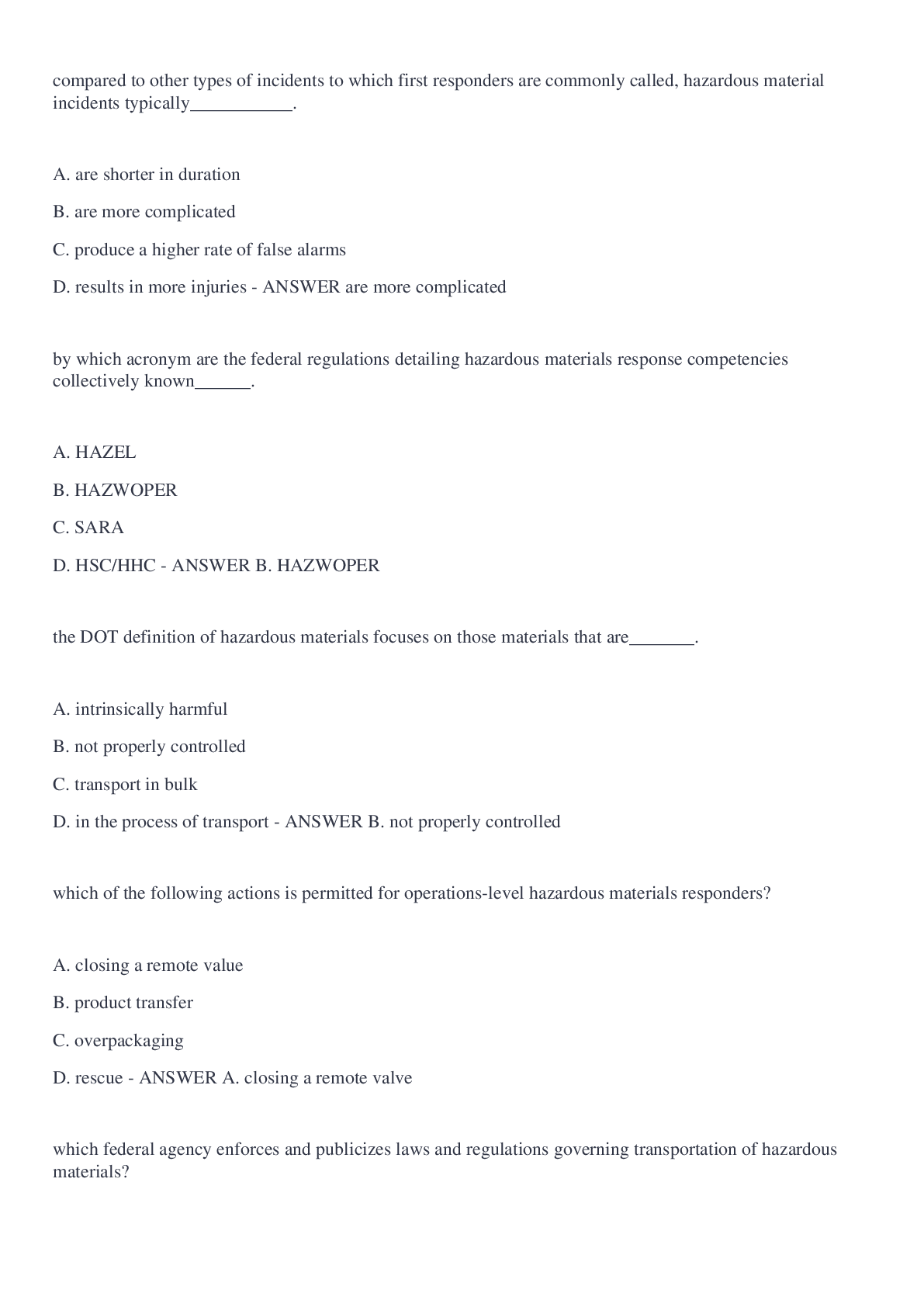
Reviews( 0 )
Document information
Connected school, study & course
About the document
Uploaded On
Jul 12, 2022
Number of pages
29
Written in
Additional information
This document has been written for:
Uploaded
Jul 12, 2022
Downloads
0
Views
79

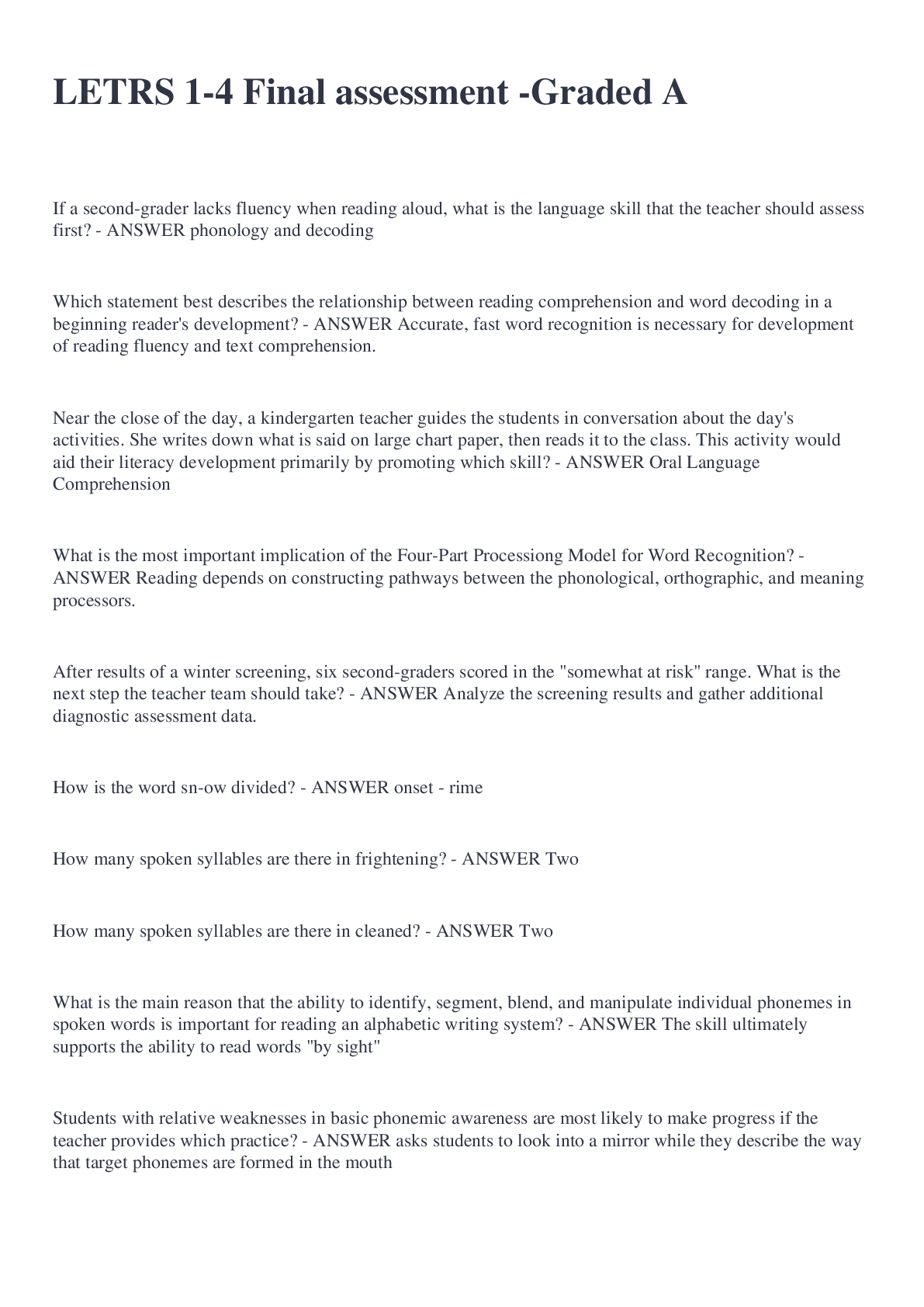


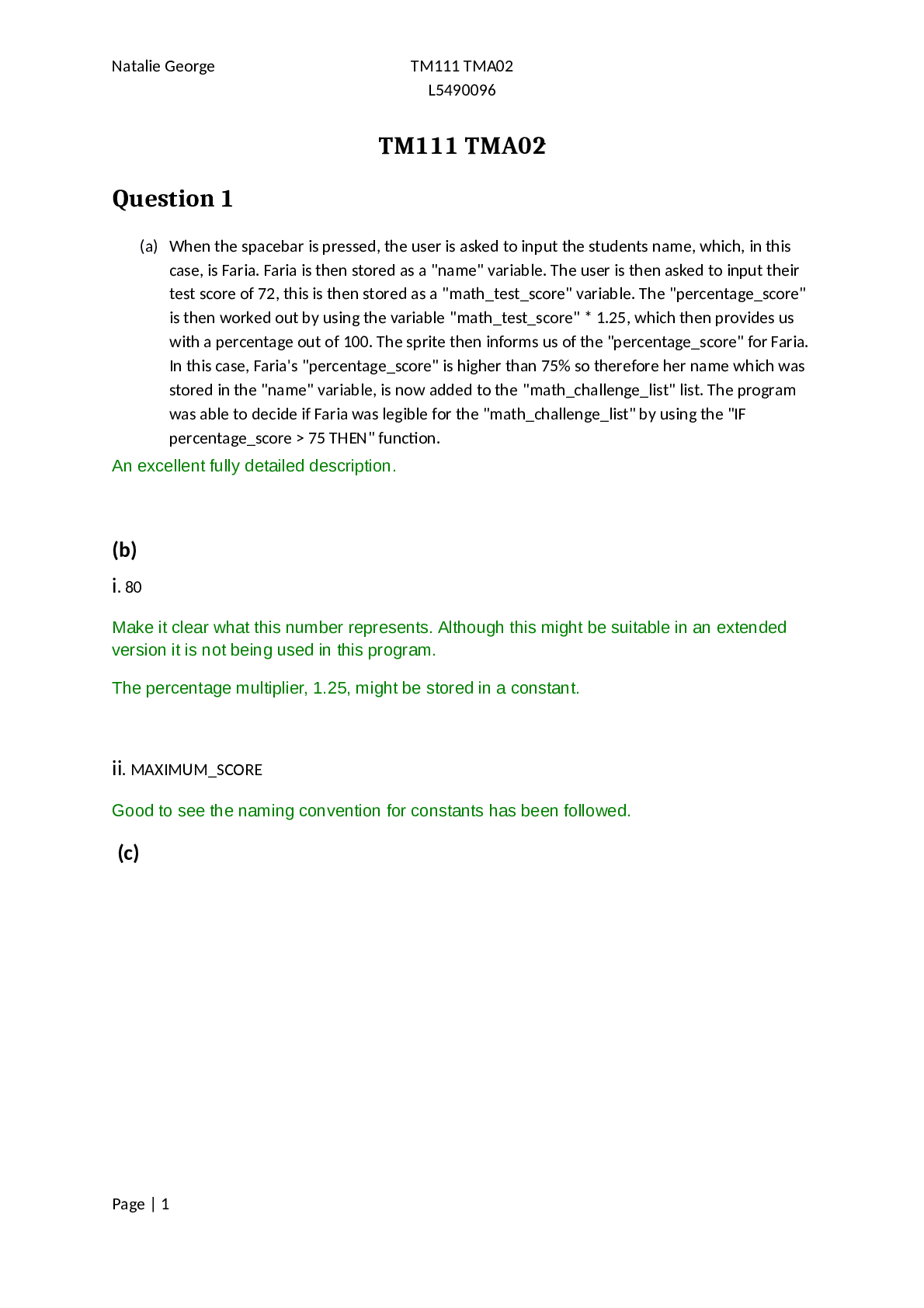


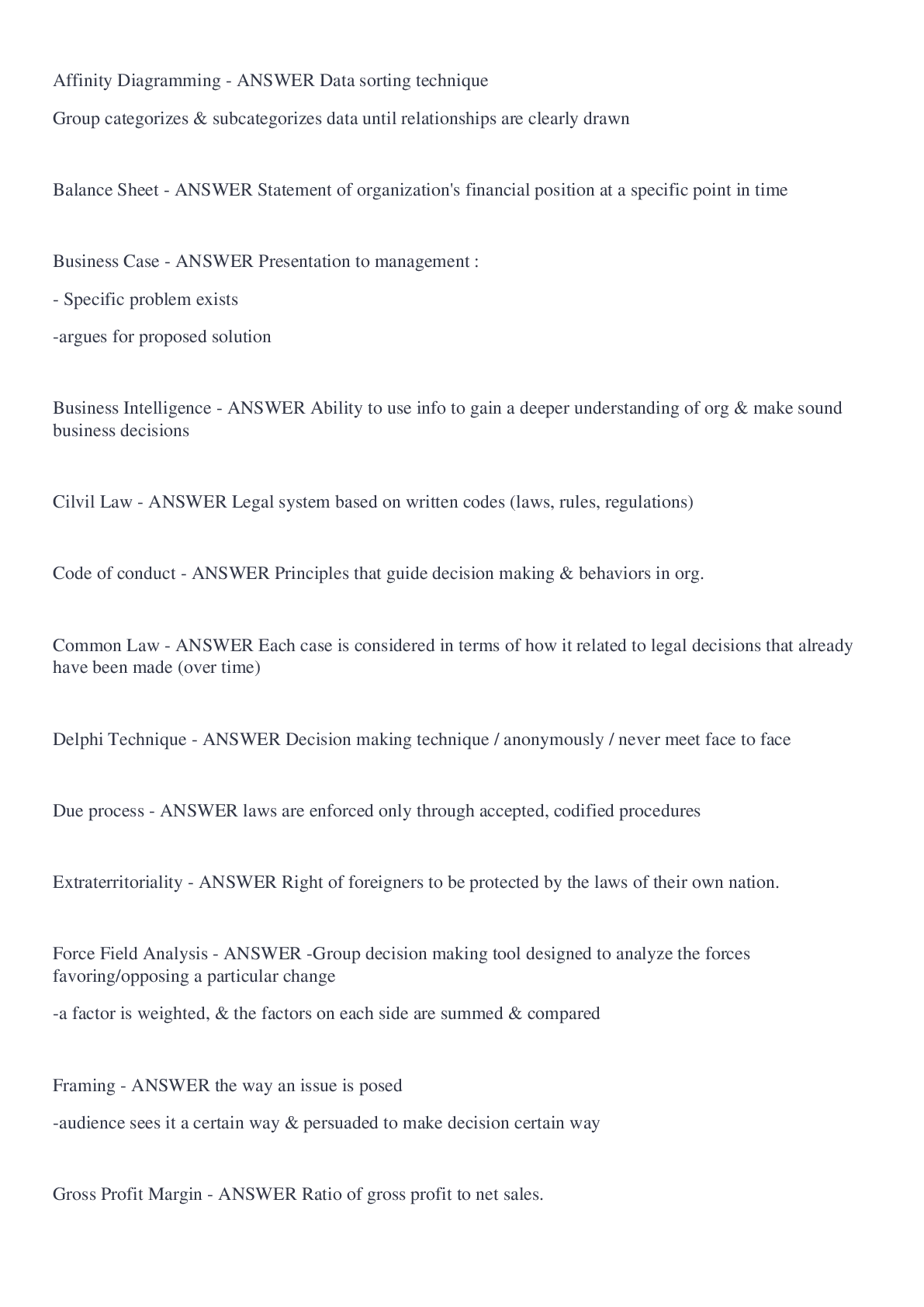

.png)
